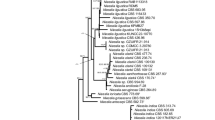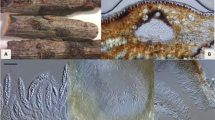Abstract
As part of a survey of foliar endophytes of conifers in the Acadian forest, we isolated a strain of Lachnellula calyciformis from a healthy Picea rubens needle. From this fungus, the new natural products deoxylachnellulone (3) and lachnelluloic acid B (5), and the known metabolite lachnellulone (1), were isolated and structurally characterized. Isolachnellulone (2) and isodeoxylachnellulone (4) occurred as isomers resulting from the facile isomerization of lachnellulone (1) and deoxylachnellulone (3), respectively. The natural products lachnellulone (1) and deoxylachnellulone (3) were also confirmed from two strains of L. calyciformis isolated as leaf and stem endophytes of Vaccinium angustifolium in eastern Canada, representing the first record of this species from a non-conifer host. All isolated compounds displayed moderate antifungal and antibiotic activity. This study of biologically active natural products from a conifer endophyte highlights the increasing apparent complexity of their collective life histories.




Similar content being viewed by others
References
Ayer WA, Villar JDF (1985) Metabolites of Lachnellula fuscosanguinea (Rehm). Part 1. The isolation, structure determination, and synthesis of lachnelluloic acid. Can J Chem 63:1161–1165
Ayer WA, Villar JDF, Migaj BS (1988) Metabolites of Lachnellula fuscosanguinea (Rehm). Part 2. The structure of lachnellulone. Can J Chem 66:506–512
Baral HO (1985) Bausteine zu einer Askomyzeten-Flora der Bundesrepublik Deutschland: in Suddeutschland gefundene inoperculate Diskomyzeten mit taxonomischen, okologischen und chorologischen Hinweisen. Beih Z Mykol 6:1–226
Barklund P, Kowalski TJ (1996) Endophytic fungi in branches of Norway spruce with particular reference to Tryblidiopsis pinastri. Can J Bot 74:673–678
Brian PW, Curtis PJ, Hemming HG, Unwin CH, Wright JM (1949) Alternaric acid, a biologically active metabolic product of the fungus Alternaria solani. Nature 164:534
Cantrell SA, Hanlin RT (1997) Phylogenetic relationships in the family Hyaloscyphaceae inferred from sequences of ITS regions, 5.8 S ribosomal DNA and morphological characters. Mycologia 89:745–755
Carroll, G. C. (1999). The foraging ascomycete. In 16th International Botanical Congress, St. Louis, MO, USA, 1999
Dharne CG (1965) Taxonomic investigations on the discomycetous genus Lachnellula Karst. J Phytopathol 53:101–144
Fujiwara T, Tsutsumi T, Nakata K, Nakatsuji H, Tanabe Y (2017) Asymmetric total syntheses of two 3-acyl-5, 6-dihydro-2H-pyrones:(R)-podoblastin-S and (R)-lachnelluloic acid with verification of the absolute configuration of (−)-lachnelluloic acid. Molecules 22:69
Hosoya T, Sasagawa R, Hosaka K, Gi-Ho S, Hirayama Y, Yamaguchi K, Toyama K, Kakishima M (2010) Molecular phylogenetic studies of Lachnum and its allies based on the Japanese material. Mycoscience 51:170–181
Huhtinen S (1993) Some hyaloscyphaceous fungi from tundra and taiga. Sydowia 45:188–198
Ibrahim A, Tanney JB, Fei F, Seifert KA, Cutler GC, Capretta A, Miller JD, Sumarah MW (2020) Metabolomic-guided discovery of cyclic nonribosomal peptides from Xylaria ellisii sp. nov., a leaf and stem endophyte of Vaccinium angustifolium. Sci Rep 10:1–17
Jankowiak R, Bilański P, Paluch J, Kołodziej Z (2016) Fungi associated with dieback of Abies alba seedlings in naturally regenerating forest ecosystems. Fungal Ecol 24:61–69
Johnston PR, Quijada L, Smith CA, Baral HO, Hosoya T, Baschien C, Pärtel K, Zhuang WY, Haelewaters D, Park D, Carl S (2019) A multigene phylogeny toward a new phylogenetic classification of Leotiomycetes. IMA Fungus 1:1
Kamei S (1962) Studies on a canker disease of Todo-fir. Res Bull Coll Exp For Coll Agr Hokkaido Univ 21:235–255
Lazarević J, Menkis A (2020) Fungal diversity in the phyllosphere of Pinus heldreichii H. Christ—an endemic and high-altitude pine of the Mediterranean Region. Diversity 12:172
Lokot IP, Pashkovsky FS, Lakhvich FA (1999) A new approach to the synthesis of 3, 6-and 5, 6-dialkyl derivatives of 4-hydroxy-2-pyrone. Synthesis of rac-germicidin. Tetrahedron 55:4783–4792
Lücking R, Aime MC, Robbertse B, Miller AN, Ariyawansa HA, Aoki T, Cardinali G, Crous PW, Druzhinina IS, Geiser DM, Hawksworth DL (2020) Unambiguous identification of fungi: where do we stand and how accurate and precise is fungal DNA barcoding? IMA Fungus 11:1–32
McMullin DR, Green BD, Prince NC, Tanney JB, Miller JD (2017) Natural products of Picea endophytes from the Acadian forest. J Nat Prod 80:1475–1483
McMullin DR, Nguyen HDT, Daly GJ, Menard BS, Miller JD (2018) Detection of foliar endophytes and their metabolites in Picea and Pinus seedling needles. Fungal Ecol 31:1–8
McMullin DR, Tanney JB, McDonald KP, Miller JD (2019) Phthalides produced by Coccomyces strobi (Rhytismataceae, Rhytismatales) isolated from needles of Pinus strobus. Phytochem Lett 29:17–24
Minter DW (2005) Lachnellula calyciformis. IMI Descriptions of Fungi and Bacteria No. 1642. CABI Bioscience, Surrey, UK pp 1–4
Miyakado M, Inoue S, Tanabe Y, Watanabe K, Ohno N, Yoshioka H, Mabry TJ (1982) Podoblastin A, B and C. New antifungal 3-acyl-4-hydroxy-5, 6-dihydro-2-pyrones obtained from Podophyllum peltatum L. Chem Lett 11:1539–1542
Moler ER, Aho K (2018) Whitebark pine foliar fungal endophyte communities in the southern Cascade Range, USA: host mycobiomes and white pine blister rust. Fungal Ecol 33:104–114
Oguchi T (1979) Canker disease of Pinus strobus and P. pumila caused by Lachnellula spp. in Hokkaido. J Jap For Sci 61:215–222
Park H, Kim DY, Kim SR, Eom AH (2018) New records of endophytic fungi isolated from leaves of Abies koreana and Taxus cuspidata in Korea. Korean J Mycol 46:241–248
Quiring D, Flaherty L, Adams G, McCartney A, Miller JD, Edwards S (2019) An endophytic fungus interacts with crown level and larval density to reduce the survival of eastern spruce budworm, Choristoneura fumiferana (Lepidoptera: Tortricidae), on white spruce (Picea glauca). Can J For Res 49:221–227
Quiring D, Adams GW, McCartney A, Edwards S, Miller JD (2020) A native endophytic fungus reduces survival of, and defoliation by, eastern spruce budworm, Choristoneura fumiferana, on white spruce, Picea glauca. Forests 11(6):659
Richardson SN, Walker AK, Nsiama TK, McFarlane J, Sumarah MW, Ibrahim A, Miller JD (2014) Griseofulvin-producing Xylaria endophytes of Pinus strobus and Vaccinium angustifolium: evidence for a conifer-understory species endophyte ecology. Fungal Ecol 11:107–113
Semar M, Anke H, Arendholz WR, Veiten R, Steglich W (1996) Lachnellins A, B, C, D, and Naphthalene-l, 3, 8-triol, biologically active compounds from a Lachnellula species (Ascomycetes). Z Naturforsch C 51:500–512
Smerlis E (1973) Pathogenicity tests of some discomycetes occurring on conifers. Can J For Res 3:7–16
Stadler M, Lambert C, Wibberg D, Kalinowski J, Cox RJ, Kolařík M, Kuhnert E (2020) Intragenomic polymorphisms in the ITS region of high-quality genomes of the Hypoxylaceae (Xylariales, Ascomycota). Mycol Prog 19:235–245
Stone JK, Polishook JD, White JF (2004) Endophytic Fungi. In: Mueller G, Bills GF, Foster MS (eds) Biodiversity of fungi: inventory and monitoring methods. Elsevier, Burlington, pp 241–270
Sumarah MW, Walker AK, Seifert KA, Todorov A, Miller JD (2015) Screening of fungal endophytes isolated from eastern white pine needles. In: Reinhard J (ed) The formation, Structure and Activity of Phytochemicals. Springer, Cham, pp 195–206
Tabuchi H, Hamamoto T, Miki S, Tejima T, Ichihara A (1994) Total synthesis and stereochemistry of alternaric acid. J Organomet Chem 59:4749–4759
Tabuchi H, Ichihara A (1994) Structures and stereochemistries of new compounds related to alternaric acid. J Chem Soc Perkin Trans 1. 1:125–133
Tanney, J.B., 2017. A taxonomic and phylogenetic investigation of conifer endophytes of Eastern Canada. PhD Thesis. Department of Biology. Carleton University, Ottawa
Tanney JB, Douglas B, Seifert KA (2016a) Sexual and asexual states of some endophytic Phialocephala species of Picea. Mycologia 108:255–280
Tanney JB, McMullin DR, Green BD, Miller JD, Seifert KA (2016b) Production of antifungal and antiinsectan metabolites by the Picea endophyte Diaporthe maritima sp. nov. Fungal Biol 120:1448–1457
Tanney, J. B., McMullin, D. R., & Miller, J. D. (2018). Toxigenic foliar endophytes from the Acadian Forest, in: Pirttilä A, Frank A. (Eds.), Endophytes of Forest Trees. Springer, Cham, pp. 343–381
Tanney JB, Seifert KA (2017) Lophodermium resinosum sp. nov. from red pine (Pinus resinosa) in eastern Canada. Botany 95:773–784
Tanney JB, Seifert KA (2019) Tryblidiopsis magnesii sp. nov. from Picea glauca in eastern Canada. Fungal System Evol 4:13–20
Tochihara Y, Hosoya T (2019) Three new species of Incrucipulum (Lachnaceae, Helotiales, Ascomycota) from Japan. Phytotaxa 403:25–38
Trifinopoulos J, Nguyen LT, von Haeseler A, Minh BQ (2016) W-IQ-TREE: a fast online phylogenetic tool for maximum likelihood analysis. Nucleic Acids Res 44:W232–W235
Visagie CM, Renaud JB, Burgess KMN, Malloch DW, Clark D, Ketch L et al (2016) Fifteen new species of Penicillium. Persoonia 36:247–280
Vu D, Groenewald M, De Vries M, Gehrmann T, Stielow B, Eberhardt U, Al-Hatmi A, Groenewald JZ, Cardinali G, Houbraken J, Boekhout T (2019) Large-scale generation and analysis of filamentous fungal DNA barcodes boosts coverage for kingdom fungi and reveals thresholds for fungal species and higher taxon delimitation. Stud Mycol 92:135–154
Yokota S, Matsuzaki S (1971) A contribution on the mechanism of disease development in Todo-fir Canker caused by Trichoscyphella calycina (Schum. Ex Fr.) Nannfeldt. Jap Forest Exp Sta Bull 238:119–139
Yuan ZL, Rao LB, Chen YC, Zhang CL, Wu YG (2011) From pattern to process: species and functional diversity in fungal endophytes of Abies beshanzuensis. Fungal Biol 115:197–213
Zhuang WY (1988) Notes on Lachnellula theiodea. Mycotaxon 31:411–416
Acknowledgments
The authors thank Kim McDonald and Blake Green (Carleton University) for technical assistance with the isolation of natural products, Mark Sumarah (Agriculture and Agri-Food Canada) for providing blueberry Lachnellula isolates, Justin Renaud (Agriculture and Agri-Food Canada) for the acquisition of HRMS data, Jeff Manthorpe (Carleton University) for providing helpful comments on the manuscript, the Microbiology Molecular Technologies Laboratory (MMTL) group of the Ottawa Research and Development Centre (Agriculture and Agri-Food Canada) for processing DNA sequences, and the DAOMC for culture preservation. We also thank S. Clayden and D. McAlpine (New Brunswick Museum) and G. Adams (JD Irving, Ltd) for organizing collecting trips in New Brunswick and Dr. David Malloch for graciously hosting J.B. Tanney.
Funding
This study was supported by the Natural Sciences and Engineering Research Council of Canada (NSERC SYN 479724-15, NSERC CRDPJ 421782-11, PGSD2-459312-2014), Mitacs (IT06326), and JD Irving, Limited.
Author information
Authors and Affiliations
Corresponding author
Additional information
Section Editor: Marc Stadler
Publisher’s note
Springer Nature remains neutral with regard to jurisdictional claims in published maps and institutional affiliations.
Electronic supplementary material
ESM 1
(PDF 648 kb)
Rights and permissions
About this article
Cite this article
McMullin, D.R., Tanney, J.B., Daly, G.J. et al. Antifungal polyketides from the Picea rubens and Vaccinium angustifolium endophyte Lachnellula calyciformis. Mycol Progress 19, 1101–1112 (2020). https://doi.org/10.1007/s11557-020-01620-5
Received:
Revised:
Accepted:
Published:
Issue Date:
DOI: https://doi.org/10.1007/s11557-020-01620-5




